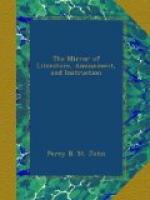“There lie the village dead, and
there too I,
When yonder dial points the hour, shall
lie.
Look round, the distant prospect is display’d,
Like life’s fair landscape, mark’d
with light and shade.
Stranger, in peace pursue thy onward road,
But ne’er forget thy lone and last
abode!”
History of Bremhill, by Mr. Bowles.
* * * * *
RETROSPECTIVE GLEANINGS.
PAPER MARKS.
[Illustration]
Paper, for the purpose of writing or printing, was first manufactured in this country, according to Anderson, about the year 1598, in the reign of Elizabeth. There is reason, however, to believe, that its manufacture existed here previous to that time. John Tate is recorded to have had a paper-mill at Hertford, in the reign of Henry VII. and the first book printed on English paper, came out in 1495 or 6. It was entitled “Bartholomeus de proprietatibus rerum,” and was printed on paper made by John Tate, jun.
The different paper marks are objects of some curiosity. Probably they gave the names to the different sorts, many of which names are retained, though the original marks of distinction have been relinquished. Post paper originally bore the wire mark of a postman’s horn, as appears on specimens of paper of the date 1679. The fleur de lis was the peculiar mark of demy, most likely originating in France. The open hand is a very ancient mark, giving name to a sort, which though still in use, is considerably altered in size and texture.
Fool’s-Cap—the name is still continued though the original design of a fool’s cap is relinquished.
Pot Paper.—There were various designs of pots or drinking vessels; this paper retains its proportions and size according to early specimens, but the mark is exchanged for that of the arms of England.
The original manufacturer in this country, John Tate, marked his paper with a star of eight points, within a double circle. The device of John Tate, jun. was a wheel; his paper is remarkably fine and good.
Various other paper marks were in use, adopted most likely at the will or caprice of the manufacturer. Thus we have the unicorn and other non-descript quadrupeds, the bunch of grapes, serpent, and ox’head surmounted by a star, a great favourite; the cross, crown, globe, initials of manufacturers’ names; and, at the conclusion of the 17th century and commencement of the last, arms appear in escutcheons with supporters.
* * * * *
SINGULAR REGULATIONS OF THE HOUSEHOLD OF HENRY VIII.
The only alteration in the following is the difference of the orthography which I have made for the benefit of your readers. They are extracts from a curious manuscript, containing directions for the household of Henry VIII.




